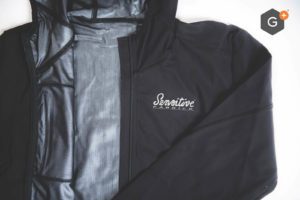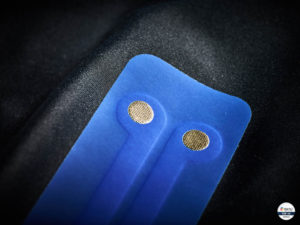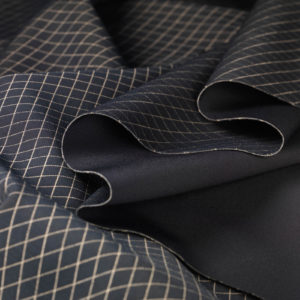
Over the past decade, we’ve seen a slow but sure evolution of wearable electronics, including smart textiles, designed primarily to monitor body functions and communicate with the Internet of Things. But a great many were not especially wearable, and some never made it out of the lab. The tide, however, seems to be turning. Première Vision (PV) in Paris, the global trade show for fashion textiles, launched its new Wearable Lab and Fashiontech in February with a conference to address the “new trend.”
“We are moving into a new phase of the creation of textiles that must remain attractive enough, while tech must stay hidden … the product must be durable, washable, secure,” says Hilary McGuinness, director of wearable marketing at Intel, Munich.
Already in 2017, we’ve seen a number of new developments in conductive textiles utilized in garments that are both wearable and useful—“smart” in both meanings of the word.

Making technology accessible
A collaboration between Noble Biomaterials, provider of conductive solutions for smart textiles applications, and Bemis Associates, producer of Sewfree® garment assembly, has created a fully-bonded kit that simplifies the process of infusing connectivity into garments. The one-step process holds the potential for bringing wearable tech to a much wider audience.
The prototype is made up of a layer of a stretchy adhesive encapsulate, made by Bemis; a layer of fully-conductive fabric using Noble’s Circuitex® technology; and a layer of Bemis’ stretchy Exoflex adhesive. The bonded kit is smooth, flexible, lightweight and soft against the skin, and makes the integration of wearable technology more accessible for factories of all sizes to execute.
Circuitex is made by permanently bonding pure silver to the surface of a textile fiber or fabric. The material acts as a sensor to detect electrical signals on the skin, transmitting them to a receiver via a wireless or a snap-on transmitter.
“The insight for the product came from the idea that electronic-enabled apparel is still apparel,” says Joel Furey, Noble Biomaterials chief commercial officer. “There are a lot of great ideas in the lab, but for the most part they are hard to translate into a garment you would want to wear.”
The unit can also be laser cut into numerous shapes and sizes for creative design flexibility. Furey indicated that Noble has recently focused on increasing Circuitex’ durability to washing and resistance to sweat—the downfall of many conductive textiles—and emphasized that the Bemis kit is fully encapsulated.

“Brands are excited to see us working to simplify the supply chain and to make it easier for them to imagine implementation,” Lacey Johnson, global marketing manager for Bemis, says.
Smart textiles that can be dyed, washed, cut to size and sold by the yard will go a long way in integrating fashion and technology, but the merger of textiles and electronics presents a number of difficulties. Schoeller Textiles’ recently-introduced heated e-soft-shell laminate addresses the challenges of embedding conductive components into the textile so that a closed loop can be achieved.
The laminate is structured like a conventional soft-shell material using Schoeller’s corkshell™ technology. The lining of the e-soft-shell is embedded with textile resistors which are interlaced by enclosed rhombic areas. The low-voltage heating areas are defined by placing flexible conductive ribbons onto the lining. The e-soft-shell material is available by the meter and can be dyed, washed and cut to size. Future plans for the textile include washable electrical contacts, smart batteries and smart phone sensor technology.
In another approach to the creation of thermally conductive textiles, Eurojersey, which supplies its high-quality Sensitive® brand warp-knit textiles to the apparel trade, has teamed up with Directa Plus, a large producer and supplier of graphene-based products for use in consumer and industrial markets worldwide.
The lamination of Directa’s Grafytherm® functional membrane containing G+ graphene to Sensitive® Fabrics creates textiles that are thermally conductive, as well as breathable, waterproof and windproof.
“These fabrics are ideal for outfits that pair functionality and aesthetics, thanks to the ultrathin layers, the raw-cut edges, and their resistance to pilling and shrinkage,” Andrea Crespi, Eurojersey general manager, says.
Directa’s G+ graphene materials are also used in a collection of thermally conductive skiwear by Colmar.

Making technology useful
“What is important for the consumers is that the added value brought by their wearable clothes responds to a need, to an actual use,” says Pascal Denizart, general director of the European Center for Innovative Textiles (CETI), at the PV Fashiontech conference.
Wave Sciences Corp. is doing exactly that by applying its patented Hearing Assistance Technology to smart garments for consumers. “The patented technology uses an arrangement of microphones and electronics in the garment to listen through noise or over distance, similar to how a parabolic dish works at an American football game to pick up the quarterback’s calls from the sidelines,” says J. Keith McElveen, president, chief technology officer, and founder of Wave Sciences.
The electronics are controlled using a phone app via Bluetooth, sending the voice of the person talking directly to the listener’s wireless ear buds, hearing aids, or headphones. Velcro pockets hold the electronics, which are currently removed for laundering.
The experimental smart garments are being targeted at and tested in government safety and defense applications, to get early stage user-feedback in challenging conditions. The current prototype is a vest made from synthetic, quick-dry materials. Flexible circuit boards cover the front and back torso, cushioned by laser-cut spacer fabrics, which together with the covering fabric provide resistance to rubbing and wind noise.
The consumer version, developed with support from Boys Town National Research Hospital, internationally recognized as a leader in hearing research, will be in the form of a more discreet T-shirt, bra, or camisole, says McElveen.
“Our garment is a hands-free, discreet solution to hearing-in-noise—nobody knows you are wearing it. Currently, all of the electronics are removable for laundering the garment, but we are moving to the next step in our development where everything but a small, detachable module is washable,” he says. “It will feel like a common undergarment.”
“We can make hearing ten times better,” McElveen continues. “If someone needs to be within two and a half feet to easily have a conversation within a coffee shop, we let them hear their order being called out by the barista across the room, 25 feet away. That changes peoples’ daily lives.”
Another highly useful innovation in wearable smart textiles is HYDRO_BOT, which offers a new way to manage one of the biggest challenges in sports, work and protective clothing: moisture management.
Osmotex AG, a Swiss/Norwegian startup, developed the electronically controlled active membrane for moisture transport in conjunction with Schoeller Textiles, wearable technology company Belginova and Empa, the Swiss Federal Laboratories for Materials Science and Technology.
Siegfried Winkelbeiner, CEO of Schoeller Textiles, says that the manufacture of the electro-osmosis panels begins with an outer layer of conductive fabric, which is then coated with a highly conductive material and glued to a membrane. The process is then done in reverse, ending with a hydrophilic inner panel, which takes up the moisture from the skin, while the membrane transports it to the outside.
Swiss high-tech sportswear maker KJUS will be the first leading brand to build the HYDRO_BOT panels into skiwear garments planned for the 2018–2019 season.
“All this we want to have guaranteed by the most up-to-date testing technology,” Winkelbeiner says. “At the end of the day our consumer does not have to worry, but just sets his comfort level on his iPhone, and the rest will be done by the jacket.”

Making technology beautiful
Technology is also being used in the creation of high-end, customizable fashion. CuteCircuit, a London-based studio that has created a number of technology-driven, LED-embellished garments for the stage and red-carpet, as well as for Easyjet flight-attendants’ uniforms, recently unveiled the first “little black dress” using graphene as a conductive material.
Graphene-enhanced sensors that capture the wearer’s breathing patterns line the top half of the dress; as the breathing pattern is analyzed by a microprocessor, the garment’s LED lights change color. CuteCircuit creative director Francesca Rosella, and CEO Ryan Genz, collaborated with scientists at the National Graphene Institute at the University of Manchester, U.K., to develop the innovative dress that changes color according to the wearer’s mood.
The ability to customize apparel is viewed by many in the industry as an important attribute in driving sales in today’s struggling retail environment. While graphene’s super-conductivity and micro-thin flexibility makes it an appealing option for technology-driven customizable apparel, its complex methods of production makes pricing somewhat prohibitive for the time being. Nevertheless, it remains one of the many technological innovations that are shifting smart textiles into real world apparel.
In April 2015, in an article about avant-garde tech-fashion designer Iris Van Herpen, the New York Times Style Magazine editor-in-chief, Deborah Needleman, wrote “The hideous term ‘wearable tech’ will hopefully disappear from our vocabularies once technology is viewed as van Herpen views it—as a tool for art, fashion or design.
Otherwise, if the goal is purely technological, it isn’t fashion you get, it’s ‘product’—however well-designed and cool it may be.” It seems that technology developers, textile designers and fashion brands may have finally gotten the message and are joining forces to create smart textiles for the real world.
Debra Cobb is a freelance writer with extensive experience in the textiles industry. She contributes regularly to Advanced Textiles Source.
 TEXTILES.ORG
TEXTILES.ORG


